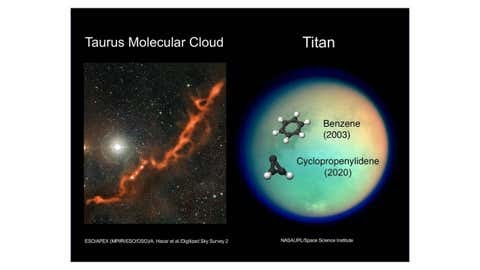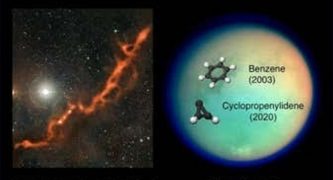
The discovery of a molecule in the atmosphere of Saturn’s moon Titan — one never detected in any other planetary atmosphere — has scientists wondering if the carbon-based molecule may be a precursor to more complex compounds that could form or feed life.
“We’re trying to figure out if Titan is habitable,” said Rosaly Lopes, a senior research scientist and Titan expert at NASA’s Jet Propulsion Laboratory (JPL) in Pasadena.
“So we want to know what compounds from the atmosphere get to the surface, and then, whether that material can get through the ice crust to the ocean below because we think the ocean is where the habitable conditions are,” Lopes said.
The fact is many chemists have probably barely heard of this molecule called cyclopropenylidene, or C3H2, which was found by using a radio telescope observatory in northern Chile known as the Atacama Large Millimeter/submillimeter Array (ALMA), according to a study published in the Astronomical Journal.
They noticed C3H2, according to a report by The Weather Channel, which is made of carbon and hydrogen, while sifting through a spectrum of unique light signatures collected by the telescope.
“When I realized I was looking at cyclopropenylidene, my first thought was, ‘Well, this is really unexpected,’” said Conor Nixon, a planetary scientist at NASA’s Goddard Space Flight Center in Maryland, who led the ALMA search.
Though scientists have found C3H2 in pockets throughout the galaxy, finding it in an atmosphere was a surprise. That’s because cyclopropenylidene can react easily with other molecules it comes into contact with and form different species.
Astronomers have so far found C3H2 only in clouds of gas and dust that float between star systems — in other words, regions too cold and diffuse to facilitate many chemical reactions.
But dense atmospheres like Titan’s are hives of chemical activity. That’s a major reason scientists are interested in this moon, which is the destination of NASA’s forthcoming Dragonfly mission.
Nixon’s team was able to identify small amounts of C3H2 at Titan likely because they were looking in the upper layers of the moon’s atmosphere, where there are fewer other gases for C3H2 to interact with.
Scientists don’t yet know why cyclopropenylidene would show up in Titan’s atmosphere but no other atmosphere. “Titan is unique in our solar system,” Nixon said. “It has proved to be a treasure trove of new molecules.” The largest of Saturn’s 62 moons, Titan is an intriguing world.
Unlike any other moon in the solar system — there are more than 200 —Titan has a thick atmosphere that’s four times denser than Earth’s, plus clouds, rain, lakes and rivers, and even a subsurface ocean of salty water. Titan’s atmosphere is made mostly of nitrogen, like Earth’s, with a hint of methane.














 0 comments
0 comments


